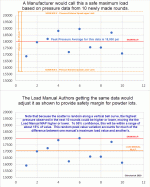In this instance, Sierra has their loads noted as "high pressure loads". A "high pressure load" below Hodgdons starting load. Someone has to be wrong.
Why?
Load data discrepancy has a negative effect on my confidence in their process.
I can understand why you might think that, but the reality is that discrepancy between different sources should give you a positive feel about their process.
This is because of the simple, yet frequently overlooked fact that the things being tested are SIMILAR but NOT IDENTICAL.
Even if great care is taken to make them as close to identical as possible, THEY WILL NOT BE IDENTICAL.
everything has tolerances. They combine in slightly different ways even when effort is made for all things to be the same. They are shooting DIFFERENT GUnS with DIFFERENT barrels, and odds are really high the brass, powder, primer and bullets are not all from the same batch.
Ever see a load shoot fine in one gun and have sticky extraction in another, despite being chambered for, and shooting the SAME ammo? I have.
seen loads crater primers in gun A and not do it in gun B. It is ENTIRELY possible to get a "SAAMI MAX" pressure load in one gun and be either above or below it, in another, using the same ammo. And when your ammo is different, the variables increase.
Ever see two "identical" guns same everything, shooting the same ammo, give different velocity readings? Same thing. Guns are SIMILAR so reloading data is a useful GUIDELINE, but they are not IDENTICAL, and you simply should not expect them to be.

